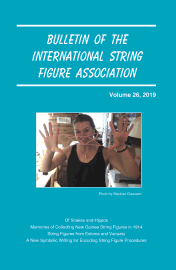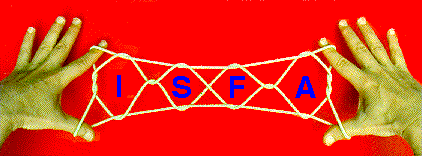Volume 26 (2019): 231 pages - Table des Matières
Edité par - Mark A. Sherman, Pasadena, California
Rédacteurs Associés - Joseph D'Antoni, Queens, New York; Myriam Namolaru, Haifa, Israel;
Belinda Holbrook, Davenport, Iowa; Stephan Claassen, Best, Netherlands.
Comité de Rédaction - Hiroshi Noguchi, Tokyo, Japan; Philip Noble, Inverness, Ecosse
Le Bulletin de l'Association Internationale du Jeu de Ficelle (BISFA) est une publication savante
présentant des documents originaux qui fait progresser notre compréhension et renforce
notre plaisir des jeux de ficelle. BISFA est publié annuellement, en septembre, par ISFA Press
(Pasadena, Californie). BISFA remplace le Bulletin de l'Association des Jeux de Ficelle,
(Toky Nippon Ayatori Kyokai), qui a été publiée en 19 volumes (1978-1993).
Les traductions proposées ne comprennent pas les illustrations et photos du texte original.
J'ai traduit ces textes pour vous donner un aperçu de la qualité et de la richesse de
ces publications.

Research Reports
Of snakes and hippopotamuses, and on the identification of individual string-figure makers from an examination of the historical record by Martin Probert, Plymouth, England (pages 1-6) - We peer back through the mists of time and try to detect the contributions of individual string-figure makers. On the way we investigate two string figures, one of a snake that has come down to us complete with method, the other of a hippopotamus that only exists on a photograph.
Memories of Collecting New Guinea String Figures in 1914: Excerpts from Kathleen Haddon’s unpublished diary by Philip D. Noble, Inverness, Scotland (pages 7-20) - In 1914 Kathleen Haddon and her father Alfred C. Haddon visited British New Guinea to do ethnological research. In this article the author traces their journey along the southern coast and recounts Kathleen’s experiences collecting string figures based on her diary entries.
Kassikangas: String figures in Estonia by Stephan Claassen, Best, Netherlands (pages 21-114) - Twelve different string figures/series and tricks from Estonia are presented. The collection is based on material from the Estonian Folklore Archives (manuscripts that are part of a 1930s game collecting competition and video recordings), on information obtained through the internet, and on material collected by the author himself. There is a considerable amount of variation in string figure making. The most common string game is the two-player game that is known in English as Cat’s Cradle, a further common figure is the action figure mimicking the movements of a saw. One short two-player series, a variant of the worldwide known Cat’s Cradle game, has probably not been recorded before, which holds also for some variations in the Cat’s Cradle game.
More String Figures from Vanuatu by Thomas Theodore Barnard (1898-1983), and Mark Sherman, Pasadena, California (pages 115-181) - To date, only two collections of string figures from islands in the New Hebrides group (Vanuatu) have been published: Dickey’s collection from 1915-17 and Deacon’s from 1926-27. In 1923, Cambridge anthropology student T.T. Barnard learned string figures while doing field work at Espiritu Santo in the New Hebrides, but his string figure field notes were never published (except for a pair of three-dimensional figures called “The Laia Flower” and “The Laia Fruit”). Recently, however, it was learned that a typescript summarizing Barnard’s collection has been in private hands for many years. The typescript includes instructions for making forty-one string figures learned from informants from four locations, namely, Espiritu Santo, Malekula, Mele (a Polynesian outlier off the coast of Efate), and the Torres Islands in the far north. The typescript is published here, as originally written in Rivers and Haddon nomenclature, for the first time. In a second section of this article the editor provides corrected instructions rewritten in standard ISFA nomenclature, as well as photographs of the final designs extended on the hands. Distribution notes are also included.
A New Symbolic Writing for Encoding String Figure Procedures by Eric Vandendriessche, Paris, France (pages 182-208) - In this article, we present a new symbolic writing for encoding string figure processes. This coding system aims to rewrite the string figure procedures as mathematical formulae, focusing on the operations implemented through these procedures. This formal approach to string figure making practices has been developed in order to undertake a systematic comparison of the various string figure corpora (at our disposal), and their statistical treatment in particular.
Letters to the Editor (pages 209-215)
Ztringz: “Old Wine in New Bags” Becomes a Large Scale Craze! - Stephan Claassen. In December 2018 the author interviewed Michael Brandt, owner of Fun Promotion, a company that markets rainbow-colored string loops ("Ztringz") and creates instructional string figure videos for their Ztringz YouTube channel. Among other things, Claassen learned that at the height of the Dutch Ztringz craze in mid-2018, the company was selling 35,000 Ztringz a week!
International Workshop in Paris, France - Philip D. Noble. The author shares his impressions of a string figures workshop he attended in May, 2018. It was organized by Eric Vandendriessche, the coordinator of a four-year research project entitled “Encoding and Transmitting Knowledge with a String” (ETKnoS), which was funded in 2016 by the French National Research Agency (ANR).
Nomenclature - by Mark Sherman (pages 216-231)
Abbreviations and terms used throughout the Bulletin are summarized and illustrated. Step-by-step illustrations for making five string figures (Look!, Drum, Two Fawns, Face Mask, and Two Arrowheads) are provided as examples.
Ajouter un commentaire





